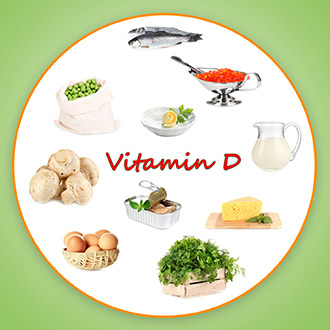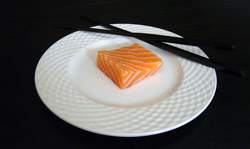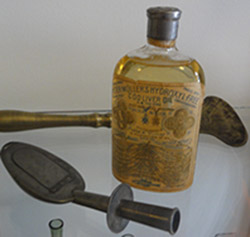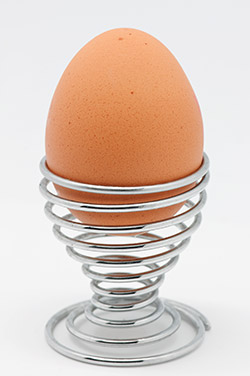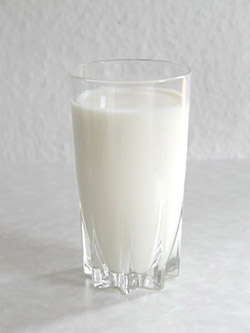Vitamin D Foods
Food Sources of Vitamin D
Vitamin D is only found in a few food sources, such as dairy foods (mostly because they are fortified with vitamin D), eggs, cold water fatty fish, and mushrooms. Moderate levels of vitamin D are also found in organ meats, including kidneys and liver, however, these foods are not commonly eaten in the West. The vitamin D concentration found in muscle meat, which is commonly eaten in the West, is considerably lower than that found in organ meats, verging on insignificant. The Western diet does not contain many foods rich in vitamin D.
Cooking and Vitamin D
Some of the vitamin D compounds found in foods are damaged by cooking. For example cooking eggs in an oven at normal temperatures destroyed 60% of the vitamin D, after 40 minutes exposure to the heat. Frying however, which is hotter than baking, but done for a shorter period of time, only destroyed about 20% of the vitamin D, while boiling destroyed only about 15%. (Technical University of Denmark) (Study)
Can We Get Enough Vitamin D From Food?
Since the recommendations for vitamin D intake have recently been increased considerably, it is pretty much impossible to meet our daily requirements for vitamin D from only food. This is especially true for those who spend most of their time indoors, and who eat no vitamin D-fortified foods. They will definitely have difficulty obtaining adequate levels of vitamin D without supplementation.
While I believe that it simply is not possible to get sufficient vitamin D from the foods we eat, sensible sun exposure can provide sufficient vitamin D during the 4 months of summer that we get here in the Pacific Northwest (and year round for those living in sunny climes). As little as 15 minutes of summer sun exposure for a fair-skinned person (up to a few hours for dark skinned individuals), is sufficient for this purpose. Remember, you make the most vitamin D when you expose a large area of your skin, such as your back and legs, rather than a small area such as your face or arms.
How much vitamin D do we need from food?
Sun exposure, combined with foods high in vitamin D, can sustain us through the sunny times, and even for a while thereafter, since the body will store vitamin D for a few months, drawing upon it as needed. If you want to get vitamin D from food alone I would suggest that you try to obtain at least 1,000 IU to 2,000 IU daily, at the very least.
The Foods Highest in Vitamin D
Below are the foods that contain rich amounts of vitamin D. These are averaged figures as different sources list slightly different amount.
Vitamin D in Fish
Various types of seafood are high in vitamin D, with the highest levels occurring in fatty fish such as salmon, tuna, and mackerel. Concentrations of vitamin D are particularly high in fish liver. Raw fish contains more vitamin D than when it is cooked, and fatty cuts will contain more than lean cuts. As well, fish canned in oil will have more vitamin D than those canned in water.
| Vitamin D Food Source | Amount |
| Salmon, wild, raw, 3.5 oz | 988 IU |
| Sockeye Salmon, 3 oz cooked with dry heat | 794 IU |
| Canned Sockeye Salmon, 3 oz with bone | 676 IU |
| Pickled Herring, 3.6 oz | 680 IU |
| 1 can (171 g) light tuna canned in oil | 459 IU |
| Mackerel, cooked, 3.5 oz | 345 IU |
| Raw, wild Oysters, 3.6 oz | 320 IU |
| 1 can (165g) light tuna canned in water | 299 IU |
| 1C canned Atlantic Sardines in oil, with bones | 287 IU |
| Sardines, in oil, drained, 1.75 oz | 250 IU |
| Caviar (Black and Red) 1 teaspoon | 37 IU |
Cod Liver Oil – Vitamin D Superfood
Cod liver oil has been used to protect against cold and flu for centuries. This protection of the lungs occurs because cod liver oil naturally contains very high levels of vitamin A and vitamin D. Check the label before purchasing as some modern cod liver oil products remove the vitamins A and D, and are sold only as a source of Omega 3 fatty acids. Cod liver oil has 1,360 IU of vitamin D in one tablespoon.
Vitamin D in Eggs
Vitamin D is found in the yolk in eggs. There have been experiments where hens have been fed vitamin D enriched diets and the eggs had substantially more vitamin D than standard eggs. The enriched vitamin D diets increased vitamin D content 160 times higher than standard eggs. The eggs contained between 200 and 8,000 IU. Vitamin D enriched may be available on the market soon. (Study)
Cooking eggs does reduce the amount of vitamin D. Shorter cooking times and lower temperatures preserve the amount of vitamin D.
| Vitamin D Food Source | Amount |
| Egg, 1 Lrg, raw | 28 IU |
| Egg, 1 Lrg, fried or poached | 25 IU |
Mushroom Sources of Vitamin D
Lightly cooked white button mushrooms provide the most vitamin D with 27 IU per 100 gram serving. Subjecting mushrooms to ultraviolet light increases their vitamin D content, and such products are now concentrated and marketed in capsules as vegan sources of vitamin D.
| Vitamin D Food Source | Amount |
| Raw mushrooms, 1/2 cup | 40 IU |
| White Button Mushrooms (lightly cooked), 3.6 oz | 27 IU |
| Shiitake mushrooms, 1/2 cup | 20IU |
Meat sources of Vitamin D
Raw and cooked beef contained 80–100 ng of vitamin D/100g, with 35–42% of the original vitamin D content being lost upon cooking. The content of vitamin D in beef is low and of little nutritional importance. Cooked pork and chicken do not contain appreciable amount of vitamin D.
| Vitamin D Food Source | Amount |
| Bologna Pork, 3.6 oz | 56 IU |
| Bratwurst, 3.6 oz | 44 IU |
| Liver, beef, pan fried 81 g | 40 IU |
| Salami, 1 oz (3 slices) | 17 IU |
Vitamin D Fortified Foods
In the North America, milk is typically fortified with vitamin D, as are most breakfast cereals. Soy milk is also often fortified in order to make it closer to milk in perceived value. Check the nutrition labels for exact amounts, since there can be a fairly wide variance between different products.
There are two things to be aware of when relying on foods fortified with vitamin D. Some products use the inferior vitamin D2, which some experts believe should be avoided because of its potential to be toxic. Other experts believe that you need much more D2 to accomplish what less D3 will do. Read the nutritional information on the packages to be sure you are getting vitamin D3. According to both the Canadian and U.S. dairy councils, most dairy products in North America are fortified with D3.
The other thing to know is that when the Boston University School of Medicine tested samples of milk, they found that 8 out of 10 samples contained either 20% less or 20% more vitamin D, than the label indicated, and some of the milk tested contained absolutely no vitamin D.
Vitamin D Fortified Dairy Products
If cheese, milk, and yogurt are not fortified, they are normally low in vitamin D, with the exception of butter because of its high fat content. However, we cannot consume sufficient butter to add an appreciable amount of vitamin D to the diet (1 tablespoon provides 8 IU).
Milk can provide up to 125 IU per cup.
Cheese can provide up to 6.6 IU in a cubic inch.
Vitamin D Fortified Soy Milk
Fortified Soy Milk can provide up to 120 IU per cup. Amounts of vitamin D vary between products.
Vitamin D Fortified Cereals
Because cereals are a breakfast staple in the North America, most commercial cereals are fortified with the essential vitamins and some minerals. Fortified cereals can provide up to 342 IU per 2 cups (Quaker Instant Oatmeal), though most are in the range of 200 IU. This can add up to a reasonable amount when the cereal is combined with fortified milk or soy milk.
Vitamin D Requirements and Testing
In order to get all the benefits of vitamin D you will need optimal blood levels of vitamin D3. The only way to know if you are getting to much or too little is a vitamin D test. We have published a blog post on vitamin D testing to help you assess whether you need to up your intake of vitamin D from foods or supplements. Don’t forget to get some sun when the weather is nice!
More information
For more information on Vitamin D see our blog posts:
Optimal Blood Levels of Vitamin D
Do We Need Vitamin D in the Summer?
NutriStart Quick D
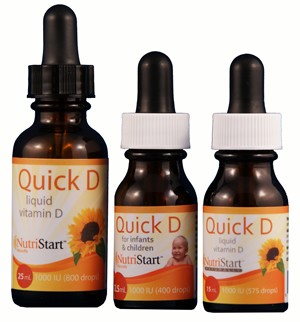 Quick D is made with some of the safest, most stable and natural ingredients available.
Quick D is made with some of the safest, most stable and natural ingredients available.
- Vitamin D3 – Cholecalciferol – the biologically active form from natural sources
- Emulsified liquid form is the most absorbable type of D3
- No unpleasant taste or capsules to take
- Glass bottle and dropper
- Convenient and easy to take
- Organic sunflower oil – a stable and healthy natural base
- Cost effective – with over 960 drops in each bottle, its one of the most economical options on the market.
- Vegetarian friendly
View NutriStart Quick D Vitamin D3
